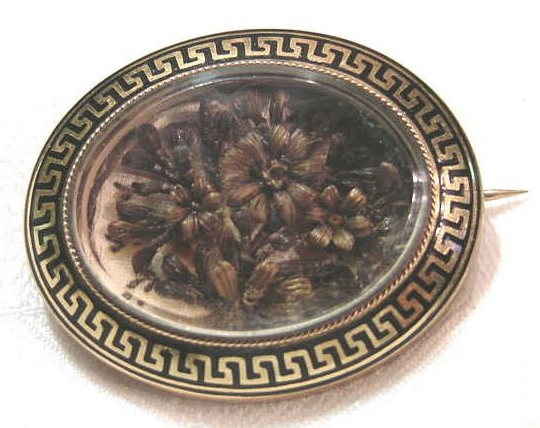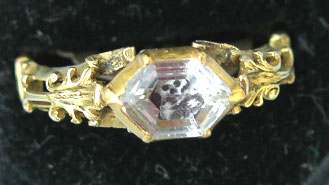Symbolism, The Greek Keys
Good morning, jewellery historians! It’s time to unlock your doors, welcome in that fresh sea breeze and start preparing a lunch of dolmades, olives, lamb, feta cheese, kolokythoanthoi and don’t forget the saganaki. Today we’re going to get Neoclassical for a while and discuss an ancient motif that still resonates with us today. A motif that has been adapted by boutique fashion houses, adorns the crests of kings, appears all around us in architecture and even pops up from time to time in those wonderful memorial and sentimental jewels we love so much.
That’s right, today we’re going to be discussing the Greek Keys in early modern mourning and sentimental jewellery! We need to be a bit more specific on this one, as a single article on the subject certainly wouldn’t do the motif justice and I would be here for several years trying to fit it all in. But, sentimental and mourning jewels are what we’re all about, so let’s begin…
To understand the motif, we need to go all the way back to the Greek Geometric Period, a time when the Mycenaean civilisation was in decline, c.1200-1050BCE. During this time, there was a wide dispersal of the culture across the Mediterranean, with reported mentions of the ‘Sea Peoples’ and the decline of the traditional Hittite and Mitanni kingdoms. Many of the reasons for this sudden change in the social/cultural/political paradigms of the region are part of much conjecture, however, what is important for us to focus upon is that where once these established kingdoms with clear art styles relating to specific periods and often the rules of kings were now under massive cultural upheaval and shift. The permeation of a set style could be related to migration, rather than direct trade; cultures were becomingly highly mobile.
The period was considered the ‘Dark Age’ of Greece, due in part to this destabilisation; loss of centralised commercial/power base, literature (Liner B script) and the abandoning of towns/villages showed a collapse of structured civilisation. Hence why much of the knowledge of the time and region comes from burial sites and the art of the time, much of what existed upon pottery. Dating from c.11th century BCE, the art began to emerge, showing simple concentric circles applied by method of brushes and a compass, intersected horizontally along the vessel with heavy (often) black lines. So, the importance of the motif is its relation towards dating from a period with very little documented evidence and what it does show is that industry continued during these Dark Ages, including metal production, farming and weaving. The technology to produce this pottery is another reflection on the continuing advancement of culture, with improvements in glazes, superior potter’s wheels (new shapes, ability to be fired at higher temperatures).
We want to look now at the Early Geometric period (900-850 BCE), where the Greek Key begins to take shape. Here, the meandering pattern is applied to vessels, which had now become taller and glazed in a method of a layer of clay, which produces a metallic colour after firing. Following this, the Middle Geometric period (950-760 BCE) showed an increased focus upon the meandering key motif, whereas it was previously relegated to a secondary flourish, it now had central placement on the vessel. Possibly the most important era in relation to our collections is the interpretation of the Late Geometric Period (760-700 BCE), a time where the vessels had reached their zenith and the meandering pattern had become intrinsically linked to the re-established (or at least organised) Greek society. The meanders of this time involved circles, swastikas, crooked lines and were balanced with many natural motifs, be they mythological/romantic scenes or simply the decoration of the natural world itself.
The importance in the identification of this motif can’t be understated; the Greek Keys are representative of their cultural use within Greek culture, from their architecture through to their obvious use in pottery. Their adaptation and dispersion throughout cultures is resonant of this; while the style itself can harken back to the natural world (consider it a depiction of the sea or two ribbons winding around to create an eternal concept), their adaptation is a reminder of a classical culture at the height of its enlightenment – culture, art, strength and sophistication are all resonant in the Greek Keys.
What is also important is that while the motif can be an affectation, it did adapt through cultural shift. From Philip II of Macedon (who used the motif on his shield) to Alexander the Great and the subsequent rise of the Roman Empire, we see that the art and culture of the Greeks permeated through the Mediterranean and Asia. By the time of the Byzantinian Empire and society’s progression into the decline of the Roman Empire leading into the Dark Ages, the Greek Key motif in all its geometric, bold simplicity has never been forgotten. Because the motif is so simple, so profound and so ubiquitous (as geometric shapes often are), they have been used by various other cultures in completely unrelated methods, such as the early Chinese of the Shang Dynasty and even pre-historic art. For the purposes of this article, we’ll stick to what’s relevant for us to know when we’re looking at our jewels.
Goodness gracious, and here I was thinking we were talking about jewellery today! What on earth happened? How could such a simple motif cause all this verbosity?
Neoclassicism! If you’ve been reading along, you know that the Neoclassical movement is one of the most important artistic shifts to impact sentimental and mourning jewellery. Far be it as a simple affectation of the times; it certainly changed the Western social landscape.
The Greek Keys relate heavy to the change in Rococo to the geometric adoption of borders and flourishes in jewellery and art c.1760. Note that the Rococo period is heavy flourished with opulent, dominating gold acanthus/floral patterns. Even ring bands were twisted in scroll motifs and designs, the art of the time is almost always complimentary to its subject For example, the twists and borders in gold-work enhance the nature of the subject of the piece (be it a stone/crystal/hair memento). The ‘Georgian Heart’ design benefits heavily from the excess of the Rococo Period, whereas the memento mori symbols begin to suffer as the symbols became anachronistic in these heavily natural designs.
So, note that the surrounding style benefits its time. Hence, the Greek Keys and the return to geometric shapes during the Neoclassical period not only make a grand statement about the return to classical art and culture, but also compliment the shape of the pieces. Much of the Neoclassical jewellery puts the focus directly on the subject. This is in the case of painted ivory depictions of mourning and sentimental scenes, painted miniatures directly relating to the subject, larger hair mementos and symbolism (such as the urn) encrusted with stones or paste. These are the subjects of the piece and these are the elements which project the empathy of the wearer outwardly. Far from the excessive domination of heavy motifs, as in Rococo, the geometric nature of the Greek Keys as a border was ideal to frame the subject of the jewel. This isn’t just the Greek Key itself, but a return to the navette shape, the oval shape and clean, simple lines that resonate from the earlier Greek pottery.
And how wonderfully did this return to simplicity enhance the statement of the jewellery at the time? Navette, oval, circular, rectangular, these are the shapes of the period c.1760-1820, with the oval taking precedence during the Regency Period.
But leave it to the Victorians to revive a revival period and use it to their benefit. C.1860, a resurgence of Neoclassical style led to the Greek Key motif being used again, but this time more prominently. At a time when empires were being built and the ability to assert dominance through mainstream art/culture, especially by adhering to the great empires of classical times, was essential. As such, while the motif is not counter-cultural as a rebellion to the prior Gothic Revival or even the Romantic periods, it bolsters an increasingly powerful and global society. This is a motif that would remain in the cultural lexicon well into the early 20th century within jewellery design.
For examples of the keys in use, let’s first look at this Swiss locket from 1866. The keys are balanced with the symbol of the Lily of the Valley (happiness/purity) and in blue enamel (considered royalty), showing the motif as standing out more than a decorative border. Importantly is the high quality of the piece an how the design was considered in the actual manufacture of the pendant. The design isn’t simply placed arbitrarily on the piece, it becomes part of the shoulders of the piece itself.
More commonly in use were the keys in this style of brooch. It was a profound border and eternal/love sentiment, one which worked within mainstream art, was easy to design into a piece (rather than a serpent, which would have many similar connotations) and also enhance the subject of the piece itself, in this case, beautiful hairwork.
The motif was ubiquitous for its time, seen in everything from rings to bracelets to earrings. Its ability to be adapted cross-culturally is important as well. It wasn’t something held in proprietary by the British; the Americans, French, Italians and basically any culture that resonated with classical aspirations not held under the weight of religious direction could adapt the motif without any issue.
Guilloché engraving is also another aspect of the Greek Key revival, though this engine turned engraving technique has more of a tenuous connection with the keys. The entwining line design shares many similarities with the concept of the Greek Keys (as do many other entwined eternal symbols), but as this is a popular method (with and without enamel), its connection isn’t a statement of the same concept.
Gosh, if you’ve made it this far, I think you deserve the lunch you started preparing some time ago. Personally, I think the Greek Keys are such an important and beautifully simple motif that I could wax lyrical about them for days. There is much more to take in on account of them; how they were used in relation to cameos and how the disintegration of the traditional empires and the rise of mass production/communication/travel in the 20th century post WWI led to its decline through the popularity of more naturalistic art styles (such as Nouveau). But, I think you have enough to consider in terms of mourning and sentimental jewels.











